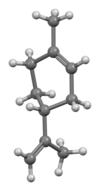Limonene
| |||

| |||
| Names | |||
|---|---|---|---|
| Preferred IUPAC name
1-Methyl-4-(prop-1-en-2-yl)cyclohex-1-ene | |||
| Other names
1-Methyl-4-(1-methylethenyl)cyclohexene
4-Isopropenyl-1-methylcyclohexene p-Menth-1,8-diene Racemic: DL-Limonene; Dipentene | |||
| Identifiers | |||
3D model (
JSmol ) |
|||
| ChEBI | |||
| ChEMBL |
| ||
| ChemSpider | |||
ECHA InfoCard
|
100.004.856 | ||
| KEGG | |||
PubChem CID
|
|||
| UNII |
| ||
CompTox Dashboard (EPA)
|
|||
| |||
| |||
| Properties | |||
| C10H16 | |||
| Molar mass | 136.238 g·mol−1 | ||
| Appearance | colorless liquid | ||
| Odor | Orange | ||
| Density | 0.8411 g/cm3 | ||
| Melting point | −74.35 °C (−101.83 °F; 198.80 K) | ||
| Boiling point | 176 °C (349 °F; 449 K) | ||
| Insoluble | |||
| Solubility | |||
Chiral rotation ([α]D)
|
87–102° | ||
Refractive index (nD)
|
1.4727 | ||
| Thermochemistry | |||
Std enthalpy of (ΔcH⦵298)combustion |
−6.128 MJ mol−1 | ||
| Hazards | |||
| Occupational safety and health (OHS/OSH): | |||
Main hazards
|
|||
| GHS labelling: | |||
   
| |||
| Danger | |||
| H226, H304, H315, H317, H410 | |||
| P210, P233, P235, P240, P241, P242, P243, P261, P264, P272, P273, P280, P301+P330+P331, P302+P352, P303+P361+P353, P304+P340, P312, P333+P313, P362, P370+P378, P391, P403+P233, P405, P501 | |||
| NFPA 704 (fire diamond) | |||
| Flash point | 50 °C (122 °F; 323 K) | ||
| 237 °C (459 °F; 510 K) | |||
Except where otherwise noted, data are given for materials in their standard state (at 25 °C [77 °F], 100 kPa).
| |||
Limonene is a colorless liquid
Limonene takes its name from
Chemical reactions
Limonene is a relatively stable monoterpene and can be distilled without decomposition, although at elevated temperatures it cracks to form isoprene.[5] It oxidizes easily in moist air to produce carveol, carvone, and limonene oxide.[1][6] With sulfur, it undergoes dehydrogenation to p-cymene.[7]
Limonene occurs commonly as the (R)-enantiomer, but racemizes at 300 °C. When warmed with mineral acid, limonene isomerizes to the conjugated diene α-terpinene (which can also easily be converted to p-cymene). Evidence for this isomerization includes the formation of Diels–Alder adducts between α-terpinene adducts and maleic anhydride.
It is possible to effect reaction at one of the double bonds selectively. Anhydrous
In another synthetic method Markovnikov addition of trifluoroacetic acid followed by hydrolysis of the acetate gives terpineol.
The most widely practiced conversion of limonene is to
Biosynthesis
In nature, limonene is formed from geranyl pyrophosphate, via cyclization of a neryl carbocation or its equivalent as shown.[8] The final step involves loss of a proton from the cation to form the alkene.
In plants
(+)-Limonene is a major component of the aromatic scents and
Safety and research
(+)-Limonene applied to skin may cause irritation from
Uses
Limonene is common as a
Limonene is used as a
Limonene is also used as a solvent for fused filament fabrication based
In preparing
Limonene, from orange peel oil, is also combustible and has been considered as a biofuel.[21]
See also
- Essential oil
- Monoterpenes
- Resin
References
- ^ US National Library of Medicine. 2017. Retrieved 22 December 2017.
- ^ ISBN 978-3-527-30673-2.
- ^ "Molecule of the Week Archive: Limonene". ACS.org. American Chemical Society. 1 November 2021. Retrieved 5 November 2021.
- ^ "limonene". merriam-webster.com. Merriam-Webster. 22 September 2023. Retrieved 23 September 2023.
- .
- S2CID 46373225.
- .
- ISBN 0-582-06009-5.
- PMID 28355238.
- S2CID 32567584.
- ^ PMID 28063510.
- S2CID 40274650.
- S2CID 21494625.
- ^ "Limonene" (PDF). EPA.gov. United States Environmental Protection Agency. September 1994. Archived from the original (PDF) on 16 October 2014. Retrieved 7 January 2022.
- ^ "Safety Data Sheet". Cutting Edge Formulations, Inc. 14 November 2014. Retrieved 7 January 2022 – via wsimg.com.
- American Philatelist. 124 (10). American Philatelic Society: 910–913.
- ^ "Using D-Limonene to Dissolve 3D Printing Support Structures". fargo3dprinting.com. Fargo 3D Printing. 26 April 2014. Retrieved 30 December 2015.
- – via ingentaconnect.com.
- ISBN 0-89189-411-X.
- ISBN 978-1-904842-42-2.)
{{cite book}}: CS1 maint: location missing publisher (link - ^ "Cyclone Power to Showcase External Combustion Engine at SAE Event". greencarcongress.com. Green Car Congress. 20 September 2007.
External links
- Mass spectrum of limonene
- Description of D-limonene on the International Chemical Safety Cards
- D-Limonene information from the United States Environmental Protection Agency




